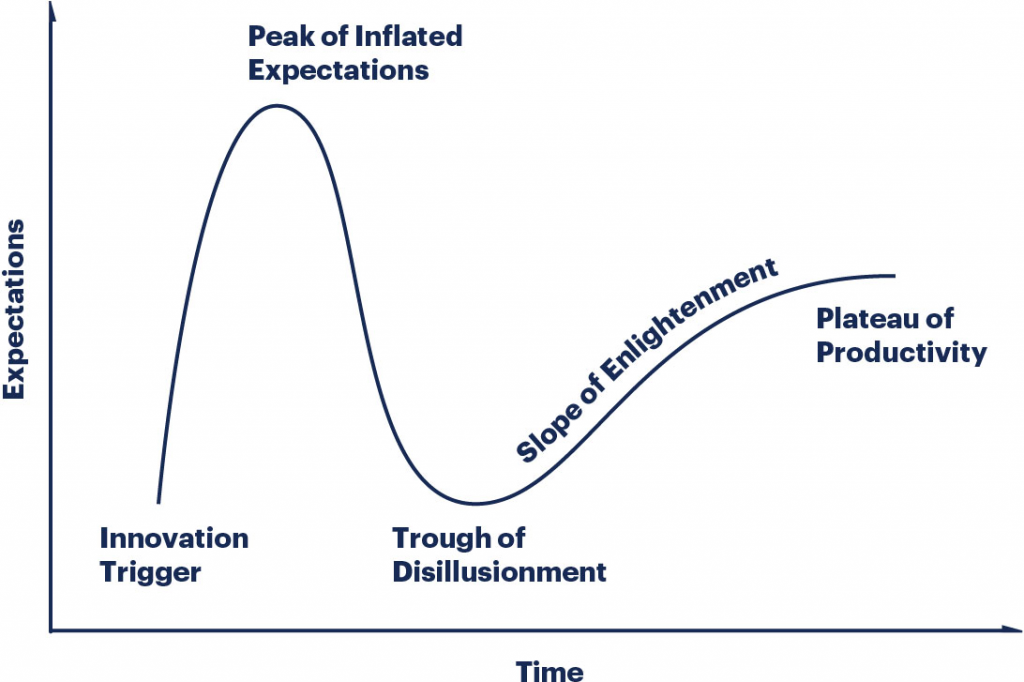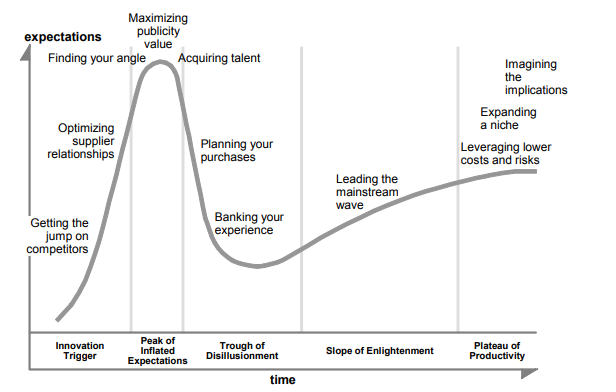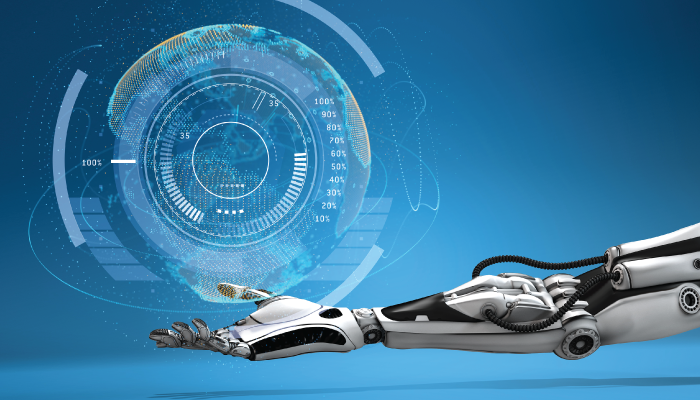The Gartner Hype Cycle is a graphical representation of the perceived value of a technology trend or innovation—and its relative market promotion. The cycle can help you understand how the perceived value of a given technology evolves over the course of its maturity lifecycle.
The maturity lifecycle accounts for several phrases: the initial (over-)enthusiasm of the industry when the technology is introduced, followed by a phase of mass adoption when we begin to evaluate the promised value, and, later, a maturity phase when the technology is improved. Over the course of this lifecycle, the Gartner Hype Cycle speculates on the potential growth trajectory and value that can be obtained by exploiting the technology in its current and next maturity phase.
This snapshot helps organizations answer a key question every time a new technology innovation presents value or disillusionment: should you invest in the technology? In this article, we’ll discuss how the Gartner Hype Cycle works and how to interpret the value of a technology innovation with this graphical representation:

How do hype cycles work?
According to Gartner’s research methodology, a technology innovation goes through five phases of its maturity cycle. Gartner uses several market indicators to establish a true representation of the expected value and maturity phase of a technology innovation. These phases include:
Innovation Trigger
This is the initial phase of a technology breakthrough. It may be a product, process, concept, trend, or idea that attracts media attention and is considered as a legitimate breakthrough. Early adopters investigate the technology, which is characterized by its novelty, high price, and expectation to undergo high customization over the course of its maturity lifecycle. The technology is accessible only to limited entities such as research labs and startup firms.
Media attention and popularity of the technology breakthrough cause a steep rise in its expected value until a peak is reached. Lack of mass adoption means that the technology’s commercial viability is unproven but also not yet contested against the rising expectations.
Examples of the Innovation Trigger:
- Flying autonomous vehicles
- Biotechnology such as artificial tissue
- 4D printing
Peak of Inflated Expectations
At this phase, the technology is widely publicized. Vendors use it as a buzzword in marketing campaigns and investors and customers see it as a hotspot. This phase often sees a surge of vendors, flooding the market with complementary and competing products.
Many organizations pioneer adoption in pursuit of the early mover advantage, while some practice caution over the limited failure stories gradually surfacing in the industry. Early adopters typically risk the challenges associated with the technology that may take years to reach the desired maturity level. At the height of this peak, some startups pioneering the technology breakthrough may see high-profile acquisitions by large enterprises.
Examples of the Peak of Inflated Expectations:
- Deep neural networks
- Digital twin
- Carbon nanotube
Trough of Disillusionment
Soon after a technology innovation reaches the Peak of Inflated Expectations, we see activity beyond early adopters. Frequently, some negative press surfaces. Organizations are now looking for meaningful value beyond initial success stories and industry hype.
As the technology fails to live up to high expectations, the growth in adoption is slowed or delayed. Vendors consolidate their offerings as experimentations fail and variations fail to gain sufficient market traction. Successful vendors reach Series B or C funding rounds with improvements validated by early adopters. The technology evolves into its next generation with only a small percentage (up to 5%) of the audience adopting it.
Toward the end of this phase, the industry questions the transformational potential of the technology. Media outlets frequently highlight the challenges, failure, and backlash facing early suppliers and adopters of the technology.
Examples of the Trough of Disillusionment:
- Blockchain
- Smart Fabrics
- Augmented Reality
- Computer Vision
Slope of Enlightenment
The technology innovation has now undergone enough success and failure stories, updates, and improvements for the industry to understand an optimal path of growth trajectory. Accordingly, second and third generations of the innovation emerge, presenting proven solutions to specific problems and industrial use cases. As a result, adoption rises closer to 20% of the audience as the technology reaches its next maturity phase.
Consulting companies are able to provide methodologies and frameworks to assist new adopters. The resulting case studies and adoption statistics are reliable, and the perceived value is now closer to reality. Toward the end of this phase, most conservative adopters and industry laggards are yet to incorporate the technology innovation to their adoption agenda in the near future.
Examples of the Slope of Enlightenment:
- Predictive analytics
- IT Risk Management solutions
- Cloud services for government
Plateau of Productivity
This is the phase of mainstream adoption (30% or more of the audience). Media outlets and technology experts regularly publish relevant news, best practices, and insights on future updates. The technology is readily produced and available as an off-the-shelf solution. A growing community builds around the technology and an ecosystem of relevant products and services emerges. Successful adoption stories across a variety of industry verticals are observed. Successful vendors reach closer to acquisitions and IPOs.
Examples of the Plateau of Productivity:
- Cloud office suites
- GPU acceleration
- Speech recognition
Different technology, different expectations change
In the Gartner Hype Cycle, each phase represents a specific magnitude of expectations. These maturity phases progress differently for every technology innovation:
- Some technologies stay at one phase longer than others, which contributes to their expected value in the industry accordingly.
- Some technology innovations follow through the maturity lifecycle faster than others, eventually reaching the final state of Plateau of Productivity. This is where the industry has adopted the said technology at scale and the perceived value translates into its real value.
- Not all technology trends follow the entire maturity lifecycle. Some fail to live up to their hype, disappearing from the hype cycle altogether. This behavior suggests that the real value was evaluated early during their maturity lifecycle and the promised rewards were deemed unrealistic or unfeasible.
- Certain innovations tend to transition back and forth between the maturity phases. Reasons include the evolution of the technology itself, where it presents new value promises as it evolves.
- The scope of evaluation changes over time. As the technology industry evolves, its appetite for risk and circumstances change. The values are perceived accordingly, and technology innovations don’t maintain a consistent magnitude of expected value over prolonged time periods.
Steering towards the Plateau of Productivity
In addition to the opportunities and risks, every technology breakthrough is accompanied by a myriad of hype. At every phase of the hype cycle, certain decisions can help effectively adopt the technology when the time is right for your specific use case and business requirements. The following policies can help better advance the adoption efforts in the right direction:

Additional resources
To learn more from Gartner, the technology research group, see our Complete Guide to 2020 Gartner Events.







